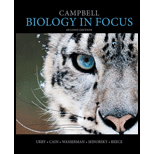
Concept explainers
The body tissue that consists largely of material located outside of cells is
- A. epithelial tissue.
- B. connective tissue.
- C. muscle.
- D. nervous tissue.
Introduction:
The connective tissues are of various types that include blood, bones and cartilage tissue. They form a layer or network of the fibrous tissue outside the cells namely osteocytes, osteoblasts in the bones, blood cells like white blood cells, red blood cells and platelets in the blood vessels and a matrix of cells in the cartilaginous tissue. The other cells in this tissue include the macrophages, mast cells, and fibroblasts. A layer of fibrous network of the connective tissue is present outside the layer of the cells in the matrix.
Answer to Problem 1TYU
Correct answer:
The connective tissue consists of several types of tissues like blood, bones and cartilaginous tissue. The cells include the osteocytes and osteoblasts inside the spongy tissue of the bones, blood cells like red blood cells, white blood cells and platelets. A layer of fibrous material is present outside the matrix of these cells in the connective tissue. Therefore, option (B) is correct.
Explanation of Solution
Reason for the correct statement:
The connective tissue forms a network of fibrous tissue outside the matrix of the cells. The cells include the osteocytes and osteoblasts inside the spongy tissues of the bones and blood cells inside the blood vessels.
Option (B) is given as “connective tissue”.
As, there is a fibrous network of the connective tissue present outside the matrix of the cells containing osteocytes, osteoblasts and blood cells inside the blood vessels supplying nutrients and gases to this tissue”, it is the right answer.
Hence, option (B) is correct.
Reasons for the incorrect statements:
Option (A) is given as “epithelial tissue”.
The epithelial tissue forms the outer covering of the layers of cells in the digestive system and respiratory system. They help in the absorption of the food in the digestive system. It does not form a material outside the cells. So, it is a wrong answer.
Option (C) is given as “muscle”.
It is made up of protein fibers like actin and myosin, which help in the locomotion and movement of the body. It does not form a material outside the cells. So, it is a wrong answer.
Option (D) is given as “nervous tissue”.
The nervous tissue consists of the brain. It does not form a material outside the cells. So, it is a wrong answer.
Hence, options (A), (C), and (D) are incorrect.
The connective tissue forms a network of the fibrous material outside the cells of the matrix like osteoblasts and osteocytes in the bones, blood cells in the blood vessels and other cells like fibroblasts and macrophages.
Want to see more full solutions like this?
Chapter 32 Solutions
Campbell Biology in Focus (2nd Edition)
Additional Science Textbook Solutions
HUMAN ANATOMY
Biological Science (6th Edition)
Campbell Essential Biology (7th Edition)
Chemistry & Chemical Reactivity
Biology: Life on Earth with Physiology (11th Edition)
Laboratory Manual For Human Anatomy & Physiology
- students in a science class investiged the conditions under which corn seeds would germinate most successfully. BAsed on the results which of these factors appears most important for successful corn seed germination.arrow_forwardI want to write the given physician orders in the kardex formarrow_forwardAmino Acid Coclow TABle 3' Gly Phe Leu (G) (F) (L) 3- Val (V) Arg (R) Ser (S) Ala (A) Lys (K) CAG G Glu Asp (E) (D) Ser (S) CCCAGUCAGUCAGUCAG 0204 C U A G C Asn (N) G 4 A AGU C GU (5) AC C UGA A G5 C CUGACUGACUGACUGAC Thr (T) Met (M) lle £€ (1) U 4 G Tyr Σε (Y) U Cys (C) C A G Trp (W) 3' U C A Leu בוט His Pro (P) ££ (H) Gin (Q) Arg 흐름 (R) (L) Start Stop 8. Transcription and Translation Practice: (Video 10-1 and 10-2) A. Below is the sense strand of a DNA gene. Using the sense strand, create the antisense DNA strand and label the 5' and 3' ends. B. Use the antisense strand that you create in part A as a template to create the mRNA transcript of the gene and label the 5' and 3' ends. C. Translate the mRNA you produced in part B into the polypeptide sequence making sure to follow all the rules of translation. 5'-AGCATGACTAATAGTTGTTGAGCTGTC-3' (sense strand) 4arrow_forward
- What is the structure and function of Eukaryotic cells, including their organelles? How are Eukaryotic cells different than Prokaryotic cells, in terms of evolution which form of the cell might have came first? How do Eukaryotic cells become malignant (cancerous)?arrow_forwardWhat are the roles of DNA and proteins inside of the cell? What are the building blocks or molecular components of the DNA and proteins? How are proteins produced within the cell? What connection is there between DNA, proteins, and the cell cycle? What is the relationship between DNA, proteins, and Cancer?arrow_forwardWhy cells go through various types of cell division and how eukaryotic cells control cell growth through the cell cycle control system?arrow_forward
 Biology (MindTap Course List)BiologyISBN:9781337392938Author:Eldra Solomon, Charles Martin, Diana W. Martin, Linda R. BergPublisher:Cengage Learning
Biology (MindTap Course List)BiologyISBN:9781337392938Author:Eldra Solomon, Charles Martin, Diana W. Martin, Linda R. BergPublisher:Cengage Learning Human Physiology: From Cells to Systems (MindTap ...BiologyISBN:9781285866932Author:Lauralee SherwoodPublisher:Cengage Learning
Human Physiology: From Cells to Systems (MindTap ...BiologyISBN:9781285866932Author:Lauralee SherwoodPublisher:Cengage Learning
 Concepts of BiologyBiologyISBN:9781938168116Author:Samantha Fowler, Rebecca Roush, James WisePublisher:OpenStax College
Concepts of BiologyBiologyISBN:9781938168116Author:Samantha Fowler, Rebecca Roush, James WisePublisher:OpenStax College





